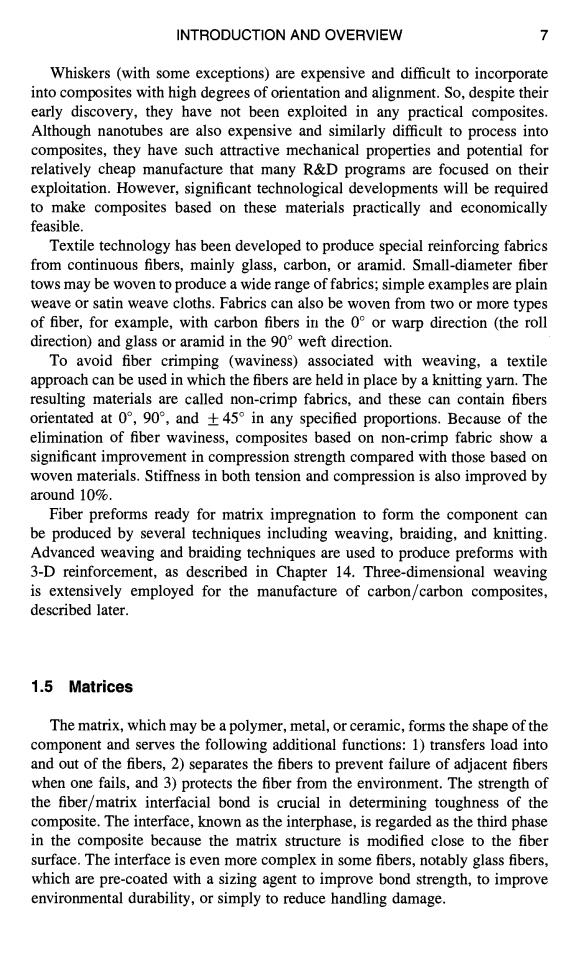正在加载图片...

INTRODUCTION AND OVERVIEW 7 Whiskers(with some exceptions)are expensive and difficult to incorporate into composites with high degrees of orientation and alignment.So,despite their early discovery,they have not been exploited in any practical composites. Although nanotubes are also expensive and similarly difficult to process into composites,they have such attractive mechanical properties and potential for relatively cheap manufacture that many R&D programs are focused on their exploitation.However,significant technological developments will be required to make composites based on these materials practically and economically feasible. Textile technology has been developed to produce special reinforcing fabrics from continuous fibers,mainly glass,carbon,or aramid.Small-diameter fiber tows may be woven to produce a wide range of fabrics;simple examples are plain weave or satin weave cloths.Fabrics can also be woven from two or more types of fiber,for example,with carbon fibers in the 0 or warp direction (the roll direction)and glass or aramid in the 90 weft direction. To avoid fiber crimping (waviness)associated with weaving,a textile approach can be used in which the fibers are held in place by a knitting yarn.The resulting materials are called non-crimp fabrics,and these can contain fibers orientated at0°,90°,and±45°in any specified proportions..Because of the elimination of fiber waviness,composites based on non-crimp fabric show a significant improvement in compression strength compared with those based on woven materials.Stiffness in both tension and compression is also improved by around 10%. Fiber preforms ready for matrix impregnation to form the component can be produced by several techniques including weaving,braiding,and knitting. Advanced weaving and braiding techniques are used to produce preforms with 3-D reinforcement,as described in Chapter 14.Three-dimensional weaving is extensively employed for the manufacture of carbon/carbon composites, described later. 1.5 Matrices The matrix,which may be a polymer,metal,or ceramic,forms the shape of the component and serves the following additional functions:1)transfers load into and out of the fibers,2)separates the fibers to prevent failure of adjacent fibers when one fails,and 3)protects the fiber from the environment.The strength of the fiber/matrix interfacial bond is crucial in determining toughness of the composite.The interface,known as the interphase,is regarded as the third phase in the composite because the matrix structure is modified close to the fiber surface.The interface is even more complex in some fibers,notably glass fibers, which are pre-coated with a sizing agent to improve bond strength,to improve environmental durability,or simply to reduce handling damage.INTRODUCTION AND OVERVIEW 7 Whiskers (with some exceptions) are expensive and difficult to incorporate into composites with high degrees of orientation and alignment. So, despite their early discovery, they have not been exploited in any practical composites. Although nanotubes are also expensive and similarly difficult to process into composites, they have such attractive mechanical properties and potential for relatively cheap manufacture that many R&D programs are focused on their exploitation. However, significant technological developments will be required to make composites based on these materials practically and economically feasible. Textile technology has been developed to produce special reinforcing fabrics from continuous fibers, mainly glass, carbon, or aramid. Small-diameter fiber tows may be woven to produce a wide range of fabrics; simple examples are plain weave or satin weave cloths. Fabrics can also be woven from two or more types of fiber, for example, with carbon fibers in the 0 ° or warp direction (the roll direction) and glass or aramid in the 90 ° weft direction. To avoid fiber crimping (waviness) associated with weaving, a textile approach can be used in which the fibers are held in place by a knitting yam. The resulting materials are called non-crimp fabrics, and these can contain fibers orientated at 0 °, 90 °, and _ 45 ° in any specified proportions. Because of the elimination of fiber waviness, composites based on non-crimp fabric show a significant improvement in compression strength compared with those based on woven materials. Stiffness in both tension and compression is also improved by around 10%. Fiber preforms ready for matrix impregnation to form the component can be produced by several techniques including weaving, braiding, and knitting. Advanced weaving and braiding techniques are used to produce preforms with 3-D reinforcement, as described in Chapter 14. Three-dimensional weaving is extensively employed for the manufacture of carbon/carbon composites, described later. 1.5 Matrices The matrix, which may be a polymer, metal, or ceramic, forms the shape of the component and serves the following additional functions: 1) transfers load into and out of the fibers, 2) separates the fibers to prevent failure of adjacent fibers when one fails, and 3) protects the fiber from the environment. The strength of the fiber/matrix interfacial bond is crucial in determining toughness of the composite. The interface, known as the interphase, is regarded as the third phase in the composite because the matrix structure is modified close to the fiber surface. The interface is even more complex in some fibers, notably glass fibers, which are pre-coated with a sizing agent to improve bond strength, to improve environmental durability, or simply to reduce handling damage